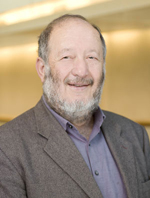April 21, 2009 - By Krista Conger

Irving Weissman
The director of stem cell research at the medical school says he is troubled by draft guidelines issued April 17 by the National Institutes of Health that would prohibit federal funding for research on stem cell lines created through a technique sometimes referred to as "therapeutic cloning" or somatic cell nuclear transfer.
Irving Weissman, MD, director of Stanford's Institute for Stem Cell Biology and Regenerative Medicine, said the SCNT technique is one way to create disease-specific human embryonic stem cell lines on which to conduct research and test therapies. He also took issue with the assertion that the NIH drew from the guidelines of the National Academy of Sciences and the International Society for Stem Cell Research, both of which sanction the use of SCNT-derived cell lines, in coming up with its draft recommendations.
"Instead of facts, the NIH turned to its own ideology in the face of the president's clear proclamation," said Weissman, the Virginia & D.K. Ludwig Professor for Clinical Investigation in Cancer Research. "It is a mystery to me why they did not consult their constituencies - the ISSCR and the NAS - before presenting a draft that, in my view, contradicts the essence of President Obama's message."
On March 9, President Barack Obama signed an executive order removing prerestrictions on the use of federal funds for research on any human embryonic stem cell line derived after Aug. 9, 2001. At the ceremony he said that it is important to ensure "that scientific data is never distorted or concealed to serve a political agenda, and that we make scientific decisions based on facts, not ideology."
In announcing the draft guidelines, acting NIH director Raynard Kington, MD, PhD, justified the restriction in part by saying that there is a lack of scientific consensus as to the necessity of funding lines derived by SCNT and that, although the technique has been used to create many embryonic stem cell lines in animals, such human embryonic stem cell lines have not yet been documented.
"We believe there is strong, broad public and scientific support for the use of federal funds for research on cell lines from embryos derived through in vitro fertilization for reproductive purposes that would not otherwise be used," said Kington, noting that similar legislation had twice passed in congress only to be vetoed by former President George W. Bush. "We do not see similar broad support for using federal funding for research on cell lines from other sources."
The SCNT technique involves removing the nucleus from an egg cell and replacing it with a nucleus from a different cell in order to create an embryonic stem cell line genetically identical to the donor nucleus. In the case of a donor who suffers from a condition such as Parkinson's disease, the process would yield an embryonic stem cell line that could be used to test specific therapies for that patient.
According to Weissman, the National Academy of Sciences unanimously advocated proceeding with SCNT research, "given its potential to produce pluripotent stem cell lines that faithfully contain the disease-causing genes from donor patients and the likely prospect that such lines would increase the understanding of disease pathogenesis and the development of treatments."
If the draft guidelines were adopted, they would underscore the continued need for the California Institute for Regenerative Medicine, which has funded grants to several scientists working to create specific human embryonic stem cell lines for research purposes. CIRM was established in 2005 by Proposition 71 in response to former President Bush's limits on federal funding of such research.
"Methods like SCNT were specifically sanctioned by Prop. 71," said Geoff Lomax, PhD, the senior officer to CIRM's Standards Working Group, which was instituted to develop ethical guidelines for the use of embryos in CIRM-funded research. "These potential restrictions on the range of research materials available for federal funding ensure that CIRM will continue to play a unique role in the world of stem cell research."
"For certain types of research, CIRM could remain important," concurred Renee Reijo Pera, PhD, director of Stanford's Center for Human Embryonic Stem Cell Research and Education.
"I am happy that these are draft guidelines," said Weissman. "Research in this area is moving very fast, and it's not possible to say which type of stem cell or iPS cell will yield the most advances. Banning funding of one line of research constitutes gambling with the health of the American people.
"Imagine the parent of a diabetic child now being told that one line of research - perhaps the only line of research - that could lead to an understanding of and treatment for their child's disease could not be funded by the NIH," Weissman added. "Policy needs to be developed as the field develops, rather than precluding something based on ideology."
The proposed NIH guidelines will be available for public comment for 30 days, and can be viewed at http://stemcells.nih.gov/Pages/Default.aspx. Comments can be mailed, or submitted electronically after the guidelines are published in the Federal Register, by April 24.
The final guidelines are scheduled to be released by the agency on or before July 7.
About Stanford Medicine
Stanford Medicine is an integrated academic health system comprising the Stanford School of Medicine and adult and pediatric health care delivery systems. Together, they harness the full potential of biomedicine through collaborative research, education and clinical care for patients. For more information, please visit med.stanford.edu.